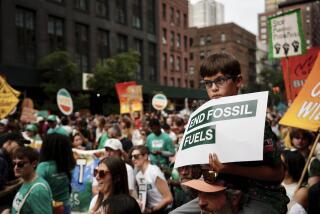Indoor Pollution Expert Echoes Tobacco Lobby View : Health: The authority on ‘sick building syndrome’ has been a consultant for the industry, documents show.
- Share via
Silver-haired and elegantly dressed, Gray Robertson has been called the “Building Doctor.”
The 52-year-old British-born chemist and indoor pollution consultant is a much-quoted authority on “sick building syndrome”--the problem of dust, gases and bacteria in weatherproof buildings that literally make the occupants sick.
In a message he’s delivered to audiences coast to coast, Robertson on Monday told a press briefing in Universal City that one indoor pollutant--tobacco smoke--is overrated and is no problem in well-ventilated buildings. A little whiff of smoke may even be useful, he said, as an indicator that ventilation is not up to par and that odorless poisons are lurking.
Although anathema to many health experts and anti-smoking activists, Robertson’s views reflect those of the tobacco industry, which has long employed him as a consultant.
But Robertson, in town Monday to drum up business for Healthy Business International, his Fairfax, Va.-based consulting firm, sought to downplay his ties to the cigarette makers and at one point denied that he’d been an industry consultant.
Robertson told reporters that a recent survey of West Coast office workers commissioned by his firm showed that 31% of Los Angeles respondents reported missing at least one day of work a year due to nausea or headaches that they blamed on the air at work. Yet Los Angeles, he noted, has a relatively low rate of smoking, and most workers did not associate their problems with tobacco smoke.
“I think there’s a message here. I think you’ve overreacted to one specific pollutant,” Robertson said.
Robertson said his firm had inspected more than 800 major buildings worldwide and had found the main culprits in “sick” buildings to be air ducts that are closed to save energy and air filters that are filthy or “no better than butterfly nets.” Several types of pollutants--ranging from allergenic fungi and viruses to fibrous glass and chemical vapors--usually are more significant than tobacco smoke, he said.
“In this room, at this minute, I guarantee that there’s thousands of different pollutants,” he told reporters.
The tobacco industry for years has sought to put sick building syndrome on the issues map as a way of deflecting attacks on public smoking. And Robertson has long been part of that strategy, according to documents obtained by The Times.
For example, an internal memo of the Tobacco Institute, the industry lobby group, in 1987 listed Robertson as one “of the consultants and allies we use to refer reporters to . . . he’s terrific and the press loves him.”
During that year, the institute sent Robertson on media tours to more than a dozen cities in at least eight states, according to itineraries prepared by the institute. Typically, his audiences never knew who the sponsor was, said a former tobacco industry official who spoke on the condition that he would not be identified.
“I was always sort of surprised that people didn’t make the obvious connection, because he would sometimes go through the interview without the word tobacco coming up,” the ex-official said.
The arrangement worked out well for the institute, the ex-official said. “Out of all the arguments they have going, this is probably the best one because it actually has some foundation to it. . . . There are real problems in sealed buildings.”
“There is an element of truth to what he’s saying,” another ex-industry official said, but Robertson may “minimize the importance of the tobacco smoke contribution.”
In a draft report, the U. S. Environmental Protection Agency has called secondhand smoke a proven cause of human cancer.
Mark Pertschuk, executive director of Americans for Nonsmokers’ Rights, said tobacco smoke is “the most serious toxin in the workplace by far, and the only remedy is its complete elimination.”
Pertschuk said he has run into Robertson a few times, and he’s usually “identified as an indoor air expert who just appeared miraculously.” It is “simply absurd and false” for Robertson “to represent himself as in any way independent on this issue,” Pertschuk said.
Asked at the end of his briefing if he had received tobacco funding, Robertson initially said he had merely inspected a few tobacco company buildings, as he had for dozens of clients.
In response to follow-up questions, he added that he done a small amount of tobacco-funded research and had twice testified for the industry--once before Congress, once before the National Academy of Sciences--and had disclosed that he was appearing at the industry’s request. He denied being a tobacco industry consultant.
When he was shown the Tobacco Institute documents during a subsequent interview, Robertson responded: “If I’ve made appearances for people . . . I don’t necessarily say I’m their consultant.”
Asked why he was reluctant to acknowledge the ties, Robertson said his involvement with the industry “has been misconstrued. . . . The vast bulk of our work has nothing to do with them.” As with all clients of Healthy Buildings, he said, “we make our study and report our findings, and if they like the findings and if they don’t like them, fine, because that’s what our findings are. . . . That is not tainting my judgment.”
“I think we’re one of many clients that Gray has,” Brennan Dawson, spokeswoman for the Tobacco Institute, said late Monday in a telephone interview. Dawson said she considered Robertson to be a consultant.
“If you’re not an employee and you’re paid to do something, I don’t know what else you’d call it,” she said.
But Dawson said she did not believe that Robertson “is doing very much for us now.” And Robertson said the Tobacco Institute had no involvement in his current West Coast tour.
He said the main purpose of the trip is to run seminars for building operators in the hope of signing them up as clients.
The seminars are being sponsored by Envirosense, a coalition of a dozen businesses, including the world’s biggest tobacco firm, Philip Morris.
More to Read
Sign up for Essential California
The most important California stories and recommendations in your inbox every morning.
You may occasionally receive promotional content from the Los Angeles Times.










